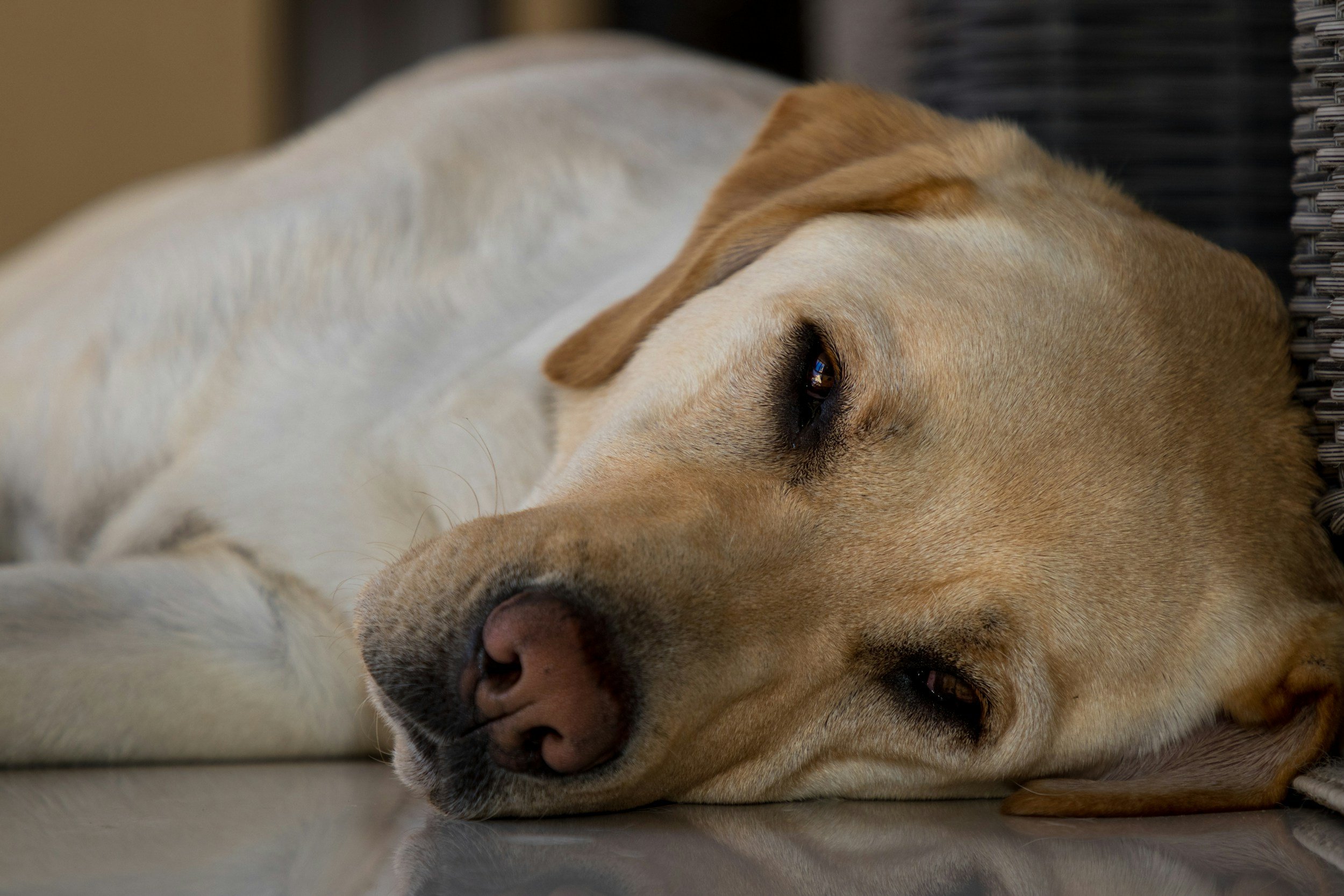
The Transition Home
This is the tricky part, so sturdy up.
From One Home to Another
The transition from one home to another will be stressful for your dog. As a result, viruses already present in your dog’s system may cause her to become ill. Most likely, this will happen within the first two weeks after adoption. We examine all dogs when they arrive to determine overall health. Any pre-existing or chronic medical conditions were explained to you when you adopted your dog. However, because the transition from a rescue to a new home can cause dogs to fall ill, you should be on the lookout for the following symptoms, and contact your veterinarian for treatment:
Diarrhea is a symptom of a wide variety of conditions. Diarrhea can be caused by stress or new food, but if your dog has diarrhea that persists for more than three days or has any traces of blood in it, please contact your veterinarian.
Sneezing, coughing, and discharge from nose and/or eyes may be symptoms of an Upper Respiratory Infection. The first and most persistent symptoms will be sneezing and coughing. As the infection progresses, you may also see discharge from the nose and/or eyes. This discharge is likely to start off clear and then turn yellow or green.
Lethargy and loss of appetite that persist for more than two days or are accompanied by diarrhea, sneezing, coughing and nasal or eye discharge could indicate an Upper Respiratory Infection.
Hair loss is a symptom of a wide variety of conditions. The most common cause of hair loss in dogs who have lived in a shelter is ringworm. Ringworm is a fungus which causes round, circular, hairless and crusty lesions that can appear on any part of a dog’s body. Ringworm can be contagious to humans, so it is important that you take your dog to your veterinarian right away if she is exhibiting any symptoms.
Medical Records
You will receive a copy of all of the medical history we have for your dog, including every procedure performed while your dog was with Fetch. You should bring these records with you when you make your first exam appointment for your new dog, so that your veterinarian has a complete medical history. You will also receive a vaccination history (read more about vaccinations on the next page), a Rabies certificate and tag for dogs over 4 months, any medications your dog is still on, and information on your new dog’s microchip and how you can register the chip to your name.
Supplies
After you get your new dog, you will need to make a stop at a pet supply store to purchase all the supplies you will need. Most pet stores allow you to bring your (leashed) dog in while you shop, which can be very useful when picking out things needing proper sizing, such as collars and crates. However, because there may be other dogs in the store (and you likely haven’t experienced your new dog’s interactions with other animals) it is probably best to leave your dog in the car with another member of your household while you shop.
Arriving Home
When you arrive home, the first thing you want to do is take your dog to his “potty spot” to give him a chance to relieve himself. (Make sure to give him a reward when he does this!) Bring your dog inside (still on leash!) and give him a quiet tour of his new home. Take him to all of the spots he’ll need to know – water bowl, bed, toy basket. Look out for things that he takes an interest in that you didn’t anticipate him getting into. Children’s toys, electrical cords, open toilet bowls and trash cans without tops are all exciting temptations for dogs who aren’t used to living in a home. You may need to do more dog-proofing once this tour is over!
Settling Down
The first day should be a pretty low-key one for your dog. He is probably feeling confused and a little overwhelmed by all the changes. You can spend the rest of your first day hanging out quietly in front of the TV or with a book, cuddling, or playing in the house or yard. Although it is tempting to invite friends over to meet your new dog, try to keep things quiet and limit introductions to household members only for the first couple of days.
Rules
As a household, decide on fair, firm “house rules” for your new dog and be sure to enforce those rules consistently from the get-go. If you don’t want your dog to jump up on your couch or bed, make sure he isn’t allowed on any furniture from the very beginning.
Early Housetraining
In addition to the tips offered earlier in this packet, don’t be surprised if your dog doesn’t pee or poop very much in the first 24 hours. This is very normal, and a result of the sudden change of environment. Keep taking him out and giving him opportunities to go, and make sure to keep an eye on him at all times so he doesn’t have the chance to have an accident indoors.
Dinner
It is common for dogs to exhibit a lack of appetite during their first day at home. Again, this is due to stress and usually not to illness or picky eating habits. Continue to offer the same food to your dog, leaving his bowl down for 10-15 minutes, until he is hungry.
Bedtime
We recommend that you have your dog sleep in the crate at night for the first couple of weeks. This will enforce a regular routine, and ensure that your dog is not getting into trouble in the middle of the night! You can put the crate in your bedroom so he doesn’t feel isolated. Before bedtime, give your dog one last opportunity to go potty outdoors in his spot. Take him indoors, put him in the crate, and shut the door for the night. Some dogs (especially puppies and adolescent dogs) might cry at first. Ignoring these noises will teach your dog that bedtime is bedtime, and that whining doesn’t get him let out of the crate. If you have a puppy under six months, expect to be awakened during the night for a potty break. Puppies aren’t able to hold their tiny bladders for very long, so it is important to take them out when they need to go. When you do this, be 7 the least exciting “you” that you can possibly be! A quick potty break is all he needs, then back in the crate. Playing or lots of attention during this nighttime break will reinforce his needing to get up – and you’ll never get any rest.
First Morning
In the morning, leash up your dog and take him outside to go potty. If you can tether your dog as you get ready for your day, do that. If not, place him on a tie-down or back in the crate while you go about your morning routine. Once you’re ready, offer your dog breakfast. Give him another chance to go potty about 15 minutes after he’s finished eating. If you’re going to be out for most of the day (at work or school), you will need to provide some kind of exercise and stimulation for your dog before you go. Depending on the energy level of your dog, this could mean a walk around your neighborhood, a game of fetch, or a brisk jog. Be aware that you may have to get up earlier than usual to accommodate your new family member’s needs. After exercise, choose a proper method of confinement (crate for up to 5 hours, dog-proofed room for more than that) and confine your dog with some sturdy chew toys that he can’t destroy or ingest.
Coming Home
The first thing you should do when you arrive home is to put your dog on leash and take him outside to go potty. Try to keep your arrivals (and departures!) low-key so your dog doesn’t get too worked up. If you are only home for lunch, give him an opportunity to stretch his legs with a quick romp in the yard, and give him some attention before confining him again. If you are home for the day, give him another exercise session!
Multi-Dog Household
Having more than one dog is a wonderful experience. Dogs are highly social creatures, and many of them really enjoy canine companionship when they are living with a well-matched dog. However, introducing a new dog into your home can feel overwhelming by itself, let alone when you already have one or more dogs at home! Dogs that live in groups naturally establish a social structure. This structure serves to maintain order, reduce conflict and promote cooperation among group members. Successful management of a multi-dog household includes keeping all members safe during the adjustment period and maintaining good interactions and a healthy relationship between your dogs. Here are some tips for making this happen:
Use confinement (crate and tether) at first, to allow your resident dog time to gradually adjust to the presence of a new dog in their household.
Always be aware of the body language of your dogs during all interactions, but especially these early ones. Information on reading dog body language can be found in this packet. Dogs give each other signals all the time. If their body language indicates that one dog is irritating the other or that they are beginning to get too charged up during play, separate them to allow time to cool off and calm down.
Feed your dogs separately to avoid squabbles over food, and supervise feedings at first.
Pick up any high value toys or objects (like pig’s ears, rawhides, NylaBones or other chewies) to avoid conflict. Some guarding of valuable resources between dogs is normal (food is a resource that’s valued very highly by canines), but should be avoided whenever possible.
Spend a sufficient amount of time with your dogs, together and separately. Just like humans need time away from their significant others or families, dogs in a family need to spend some time separate, too. Spending one-on-one time with each of your dogs will help to strengthen their bonds with you, and spending time together will allow them opportunities to learn how to co-exist peacefully.
Do not leave your dogs alone unsupervised! It is important that you monitor all interactions for the first several weeks. Confine one (or both) of your dogs whenever you cannot supervise them, until you are 100% comfortable that there will be no fights when you are not present to manage and intervene.
Brush up on your resident dog’s obedience training! And, of course, spend time training your new dog. Good obedience will make management of your multi-dog household much, much easier.
